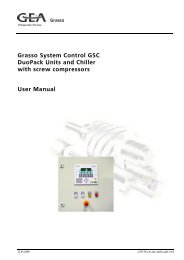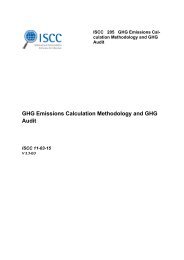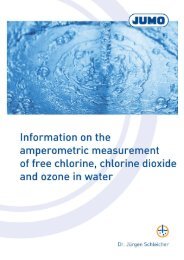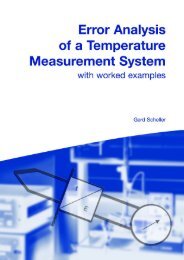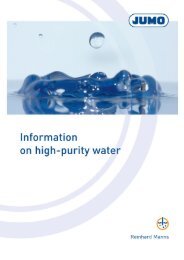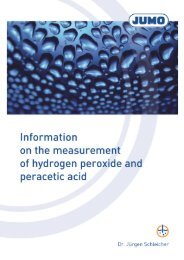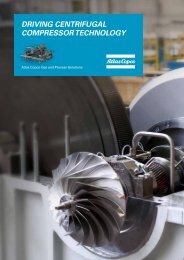FAS622en_pH measurement
You also want an ePaper? Increase the reach of your titles
YUMPU automatically turns print PDFs into web optimized ePapers that Google loves.
4 Applications<br />
4.1.1 Inlet to the plant<br />
The <strong>pH</strong> <strong>measurement</strong> in the inlet to the plant serves to protect the sewer system and the structures.<br />
Waste water with a <strong>pH</strong> value below 6 or above 9 results in costly material damage. Normally,<br />
exceeding or falling below the permissible <strong>pH</strong> range for a short time is of no consequence. The larger<br />
quantities of water in the basins of the plant are sufficient to adequately dilute and neutralize<br />
smaller quantities of acids or bases. However, when there are long-term or frequent infringements,<br />
the cause must be found and the inflows eliminated. If the monitoring of the inlet is to be effective,<br />
it must operate continuously, round the clock. A permanently installed <strong>measurement</strong> system with<br />
suitable recording means is required for the <strong>measurement</strong>.<br />
Measurement setup<br />
The large quantities of fibrous contaminants as well as grease and oil pose a problem for the <strong>pH</strong><br />
<strong>measurement</strong> by becoming entangled or forming a coating on the <strong>pH</strong> electrode. Electrodes that<br />
have been contaminated in this way become extremely sluggish and produce false measured values.<br />
The fitting must have as smooth a shaft as possible, and be freely suspended at a position with the<br />
best possible water flow. Any tangled fibers on the fitting must be removed at regular intervals.<br />
To avoid the reference electrode clogging rapidly, it should have an annular diaphragm. Basically, it<br />
is advisable to clean the electrode every 14 days, depending on the loading. Grease and oil deposits<br />
can be easily removed with a little washing-up liquid and warm water.<br />
In waste-water treatment plants, lightning strikes are one of the most common causes of severe<br />
damage to the <strong>measurement</strong> setup. For this reason, the transmitter must have a good surge voltage<br />
protection.<br />
4.1.2 Biotower<br />
General<br />
An additional <strong>measurement</strong> point for the <strong>pH</strong> value is the sludge in the biotower. The <strong>pH</strong> value has a<br />
significant effect on the activity of the micro-organisms. The micro-organisms occurring in this anaerobic<br />
process react much more sensitively to their environmental conditions than aerobic forms.<br />
Even with only small <strong>pH</strong> variations, some populations disappear and others are formed.<br />
With a <strong>pH</strong> value below 7 (neutral point) the sludge breaks down (acid sludge) and evil-smelling decomposition<br />
gases are formed (including hydrogen sulfide). The desired reduction in volume proceeds<br />
even more slowly and only to a limited extent. The sludge so formed is slimy and is difficult<br />
to dehydrate.<br />
Under basic (alkaline) conditions, in the range from <strong>pH</strong> = 7 to <strong>pH</strong> = 8, the desired odorless methane<br />
decomposition occurs. Precise monitoring and adjustment of the <strong>pH</strong> value is an essential requirement<br />
here for optimal methane gas production.<br />
Measurement setup<br />
Permanent <strong>pH</strong> monitoring can realistically only be achieved with a sensor mounted direct in the<br />
main pipeline, i. e. a fixed <strong>measurement</strong> setup. The sensor is exposed to increased stress with these<br />
<strong>measurement</strong>s:<br />
- A high solids content in the sludge leads to heavy contamination.<br />
- Excess pressure stresses the reference system of the <strong>pH</strong> <strong>measurement</strong> system.<br />
- Hydrogen sulfide poisons the reference system.<br />
34 4 Applications JUMO, FAS 622, Edition 04.07



